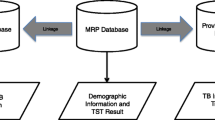Abstract
Background
Dialysis patients are at increased risk of tuberculosis (TB) and anergy due to attenuated cellular immunity.
Aim
To define specific risks of TB in anergic and non-anergic dialysis patients.
Methods
A total of 272 dialysis patients were enrolled in this prospective study over a 36-month follow-up. Entering the study, participants had Mantoux and 2,4-dinitrochlorobenzene skin tests and their cell-mediated immunity (CMI)-index was estimated. Patients were classified as anergic (CMI-index ≤2 and Mantoux ≤4 mm) or non-anergic. Specific relative risks of TB were then calculated, using data from both the general population and 49 non-uremic health care workers. The independent effect of sex, age and diabetes mellitus was determined using Cox’s proportional hazard method.
Results
Among the 116 (42.6%) anergics 13 (11.2%), and among the 156 non-anergics 11 (7%) developed active tuberculosis. Anergics had a significantly higher risk of TB than non-anergics (Adjusted Relative Risks, 98.3, 95% CI 58.65–113.6 versus 61.6, 95% CI 13.6–72.1, P = 0.003). Tuberculin reactivity was weakly associated with the subsequent risk of TB (r = 0.51). The latter showed a steadily decreasing trend with increasing CMI-index (r = −0.99).
Conclusion
Anergy distorts the association of tuberculin reactivity with risk of TB. Anergic dialysis patients are at increased risk of developing active TB and chemoprophylaxis is justified in them too.
Similar content being viewed by others
References
Descamps-Latsca B (1993) The immune system in end-stage renal disease. Cur Opin Nephrol Hypertens 2(6):883–895
American Thoracic Society, Centers for Disease Control (2000) Targeted tuberculin testing and treatment of latent tuberculosis infection. Am J Respir Crit Care Med 161(Suppl):S221–S228
Reider HL (2002) Interventions for tuberculosis control and elimination. Preventive chemotherapy. International Union against Tuberculosis and Lung Disease. chapter 4:127–146
Cox DR (1972) Regression models and life tables (with discussion). J R Stat Soc B 34:187–220
Pradhan RP, Katz LA, Nidus BD et al (1974) Tuberculosis in dialyzed patients. JAMA 229:798
Hussein MM, Mooij JM, Roujouleh H (2003) Tuberculosis and chronic renal disease. Semin Dial 16(1):38–44
Cohn DL (2003) Treatment of latent tuberculosis infection. Semin Respir Infect 18(4):249–262
Korzets A, Gafter U (1999) Tuberculosis prophylaxis for the chronically dialysed patient. Nephrol Dial Transplant 14:2857–2859
Tuberculosis Research Center (ICMR), Chennai, India. Association of initial tuberculin sensitivity, age and sex with the incidence of tuberculosis in South India: a 15 year follow-up. Int J Tuberc Lung Dis 7(11):1083–1091
Fang HC, Chou KJ, Chen CL, et al (2002) Tuberculin skin test and anergy in dialysis patients of a tuberculosis-endemic area. Nephron 91(4):682–687
Woeltje KF, Mathew A, Rothstein M et al (1998) Tuberculosis infection and anergy in hemodialysis patients. Am J Kidney Dis 31(5):848–852
Slovis BS, Plitman JD, Haas DW (2000) The case against anergy testing as a routine adjunct to tuberculin skin testing. JAMA 283(15):2003–2007
Malaviya AN, Sehgal KL, Kumar R, Dingley HB (1975) Factors of delayed hypersensitivity in pulmonary tuberculosis. Am Respir Dis 112(1):49–52
Yoneda T, Mikami R, Sakaguchi Y, Shirai F. The relationship between natural killer cell activity and delayed-type hypersensitivity reaction to 2,4-dinitrochlorbenzene in the spectrum of chronic, intractable pulmonary tuberculosis
Watson M, Briggs J, Diamantopoulos A (1979) Endogenous cell-mediated immunity and outcome of renal transplantation. Lancet 22/29, 1323
Millard PS, Wilcosky TC, Reade-Cristopher SJ, Weber DJ (1996) Isoniazid related fatal hepatitis. West J Med 164:486–491
McGlynn KA (1986) Isoniazid prophylaxis in hepatitis B-carriers. Am Rev Respir Dis 134:666–668
Siskind MS (1993) Isoniazid-induced neurotoxicity in chronic dialysis patients: report of 3 cases and a review of the literature. Nephron 64:303–306
Author information
Authors and Affiliations
Corresponding author
Rights and permissions
About this article
Cite this article
Christopoulos, A.I., Diamantopoulos, A.A., Dimopoulos, P.A. et al. Risk of tuberculosis in dialysis patients: association of tuberculin and 2,4-dinitrochlorobenzene reactivity with risk of tuberculosis. Int Urol Nephrol 38, 745–751 (2006). https://doi.org/10.1007/s11255-006-9051-3
Published:
Issue Date:
DOI: https://doi.org/10.1007/s11255-006-9051-3



